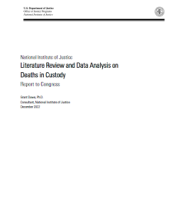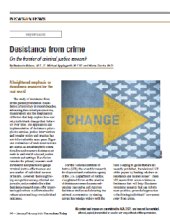Corrections research
Restoring Promise: A Randomized Control Trial Examining the Impact of an Innovative Young Adult Housing on Reducing Violence
The Overlooked Role of Jails in the Discussion of Legitimacy: Implications for Trust and Procedural Justice
National Institute of Justice Literature Review and Data Analysis on Deaths in Custody, Report to Congress
Assessing the Effectiveness of Interventions Designed to Reduce Racial/Ethnic Disparities in the Justice System: A Systematic Review and Meta-Analysis
Criminal Justice Requirements and Resources Consortium
NIJ's Technology Assistance For Corrections
Building Knowledge on Female Offenders
NIJ Tests New Technologies
Desistance: It's a Process, Not an Event
Taking Stock: An Overview of NIJ's Reentry Research Portfolio and Assessing the Impact of the Pandemic on Reentry Research
Over several decades, the National Institute of Justice (NIJ) has made significant contributions to the field of reentry, specifically what works for whom and when. In recent years, however, the global pandemic has made it increasingly difficult to conduct research on and with populations involved with the justice system. During this time, many researchers assessing various justice-related outcomes were unable to continue their inquiries as planned due to a lack of access to their populations of interest, forcing many to pivot and rethink their research designs.
See the YouTube Terms of Service and Google Privacy Policy
Desistance: It's a Process, Not an Event
Non-random Study Attrition: Assessing Correction Techniques and the Magnitude of Bias in a Longitudinal Study of Reentry from Prison
Activism and Radicalism in Prison: Measurement and Correlates in a Large Sample of Inmates in Texas
Desistance from Crime: On the Frontier of Criminal Justice Research
Multilevel Evaluation of Project Safe Neighborhoods
Project Safe Neighborhoods (PSN) is a DOJ-sponsored initiative to reduce violent crime, particularly gun crime, by fostering cooperation by criminal justice agencies and local partners to develop and implement strategic approaches.
See the YouTube Terms of Service and Google Privacy Policy
NIJ-Funded Research on Mass Shootings to Advance Evidence-Based Policy and Practice
Mass public shootings continue to threaten communities in the United States, yet research on this criminal phenomenon is limited. In this full thematic panel, renowned experts will present a series of research projects summarizing NIJ-funded research projects’ newest findings on public mass shootings. The discussion will focus on NIJ’s investment to address the phenomenon of mass shootings through innovative study approaches to advance our understanding of mass shootings and inform prevention efforts. The implications of this research to criminal justice will also be discussed.
See the YouTube Terms of Service and Google Privacy Policy
Implementing NAGPRA Connecting Medical Examiner and Coroner Offices to Tribal Partners
This project is designed to connect tribal partners to ME/C offices to facilitate successful disposition protocols for non-forensically significant Native American remains that are compliant with the Native American Graves Protection and Repatriation Act of 1990 (NAGPRA).
See the YouTube Terms of Service and Google Privacy Policy
Desistance From Crime: Implications for Research, Policy, and Practice
Most scholars would agree that desistance from crime – the process of ceasing engagement in criminal activities – is normative. However, there is variability in the literature regarding the definition and measurement of desistance, the signals of desistance, the age at which desistance begins, and the underlying mechanisms that lead to desistance. Even with considerable advances in the theoretical understanding of desistance from crime, there remain critical gaps between research and the application of that research to practice.
See the YouTube Terms of Service and Google Privacy Policy






